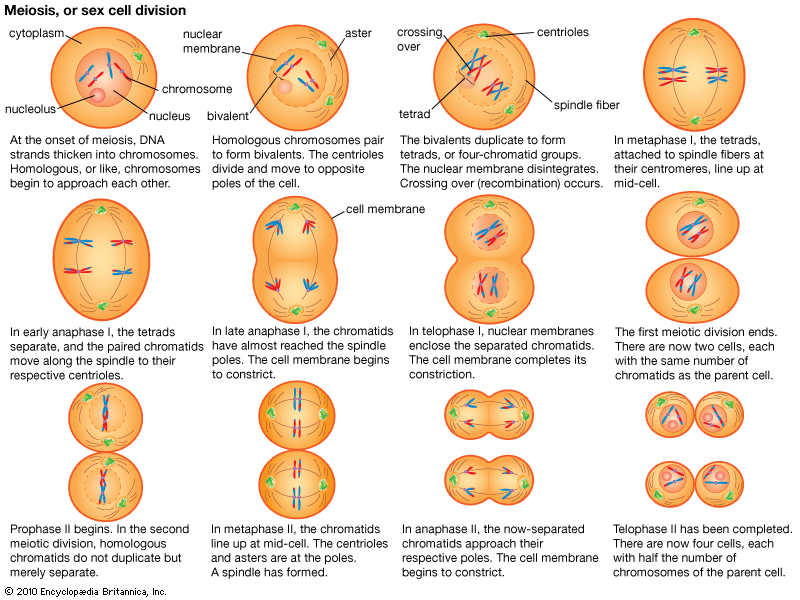Meiosis Cell Division Assignment Help
Meiosis is the type of cell division where chromosome number is reduced to half. Meiosis is essential for sexual reproduction in plants, animals, fungi as well as human beings. Meiosis is also called reductional division because chromosome reduces to half, thus changing diploid set to haploid ones.
Phases of Meiosis
Meiosis is divided into two phases or parts, meiosis I and meiosis II but before entering meiosis, cell first make pre- preparation, therefore a stage called interphase occurs before proceeding to meiosis.
Interphase: It is again divided into two stages, the first stage is the G1 phase or growth 1 phase where protein in a cell are synthesized rapidly. Second is the S phase or synthetic phase where genetic material in a cell undergoes replication. In case of mitosis there is one more stage called Growth 2 phase or G2 phase but this phase is absent in meiosis. After interphase, meiosis begins, meiosis I starts first and then Meiosis 2.
1. Meiosis I: in this stage the complete work of genetic recombination and exchange of genetic material takes place. Different events and steps that clarify the process are:
Prophase I: it is divided into different stages-
- Leptotene:
- At this stage, condensation of chromosome starts.
- Coiling of chromosome fiber takes place.
- Two chromatins are not completely distinguishable.
- Elements of synaptonemal complex gets assemble.
- Zygotene:
- At his stage, synapses i.e. homologous pairing of chromosome takes place.
- The pair chromosomes are called tetrad or bivalent.
- Pairing is exact and accurate.
- Main elements of synaptonemal complex get assembled.
- Pachytene:
- In this stage crossing over takes place i.e. exchange of segment between non-sister chromatin occurs.
- The point of exchange is called chiasmata.
- Therefore, recombination occurs.
- Diplotene:
- Separation of homologous chromosome takes place.
- Synaptonemal complex gets degraded.
- Still, divalent remain bound to chiasmata.
- Diakinesis:
- Further condensation of chromosome takes place.
- Nuclei disappear.
- Nuclear membrane also disappears.
- Formation of spindle fibers.
Meiosis Cell Division Assignment Help By Online Tutoring and Guided Sessions at AssignmentHelp.Net
Metaphase I
- Chromosomes that are paired in tetrad arrange itself on metaphasic plate where chromosome of each pair faces each pole.
- Attachment of chromatids to kinetochore.
- The homologous chromosome aligns at the equatorial plane.
Anaphase I
- Homologous chromosomes get apart due to pulling of chromosomes away from each other.
- Kinetochore gets shortened.
- Therefore, tow haploid set of chromosome are formed.
- Cell elongates.
- Disjunction of chromosome occurs.
Telophase I
- Each half of the chromosome arrive at the pole and each chromosome consist of a pair of chromatid.
- Disappearance of microtubules.
- Formation of new nuclear membrane.
- Chromosome uncoils to form chromatin.
Before the beginning of meiosis II, cell first enters the resting stage also called interkinesis.

Picture Reference: biology- pictures blogspot.com
Meiosis II
At these stages, mostly division of cell or it can be said that cell undergoes changes where daughter cell will have a single chromatid.
Prophase II
- Formation of spindle fibers.
- Disappearance of nuclei.
- Nuclear membrane gets degenerate.
- Centrioles move towards the polar regions.
Metaphase II
- Chromosome pointed towards the metaphasic plate.
- The two sister chromatid are not genetically identical due to crossing over during meiosis I
- The kinetochore of sister chromatid are attached to microtubules extending from opposite poles.
Anaphase II
- Centrosome gets separated and sister chromatid falls apart.
- Sister chromatids moves to the opposite poles.
Telophase
- The length of chromosome increases.
- It gets uncoiled
- Spindle fibre disappears.
- Nuclear envelope reforms.
- Formation of cell wall.
Therefore after this few steps meiosis is completed with division of cell into four new daughter cells. This way all these formed daughter cells have a single chromatid.
Importance of meiosis
Meiosis has great importance in living organism mostly plants, animals and human. Since diploid cell becomes haploid at the end of meiosis, therefore this maintains the chromosome number by keeping any organism diploid generation after generation. Moreover, the crossing over that takes place brings new combination in the gene and most importantly, repairing of any segment of incorrect portion is wonderfully facilitated by the process of meiosis. Therefore, all this results in variation due to which offspring with some of the unique character, both phenotipically and genotipically are produced. Hence, meiosis is important and helps in progress of life.
Read More about the Difference between Mitosis and Meiosis


